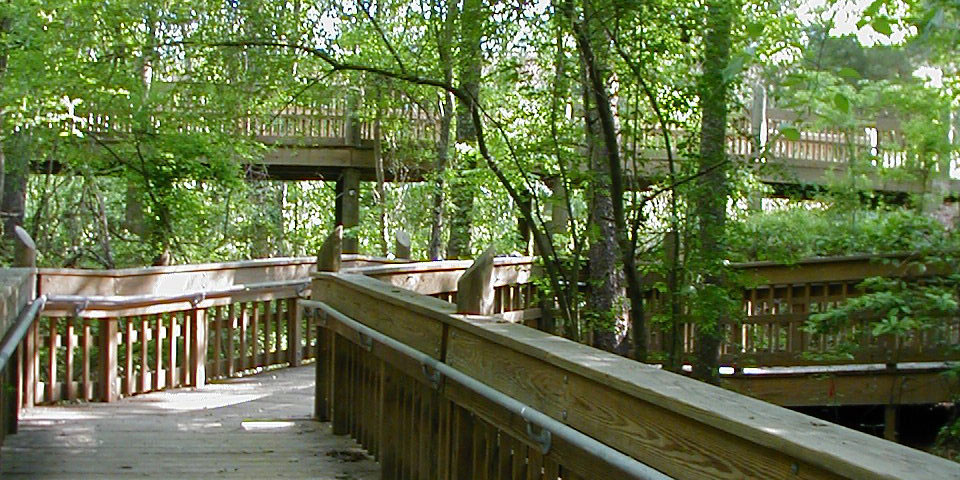

An Emerald on the Pear
The following article about birding on the Nature Trails at the LeFleur's Bluff State Park in Jackson, Mississippi was written for us by Steve Peterson, a member and past-president of the Jackson Audubon Society. He is a retired science teacher and Mississippi Museum of Natural Science Field Associate, and has been observing the bird life of the park, especially the owls, for many years. The bird photos are compliments of Bill Stripling, another member of the society.
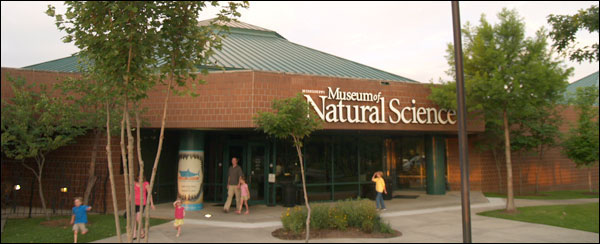
I had a few hours to spare one summer morning, so I went to the Mississippi Museum of Natural Science located in LeFleur's Bluff State Park in Jackson. I walked through the museum and to the head of the nature trails. Walking and exploring the trails is something I've been doing since at least 1971 and it never gets old.
The Mississippi Museum of Natural Science in Jackson is a great place to learn more about the birds of Mississippi. Photo by Bill Pitts
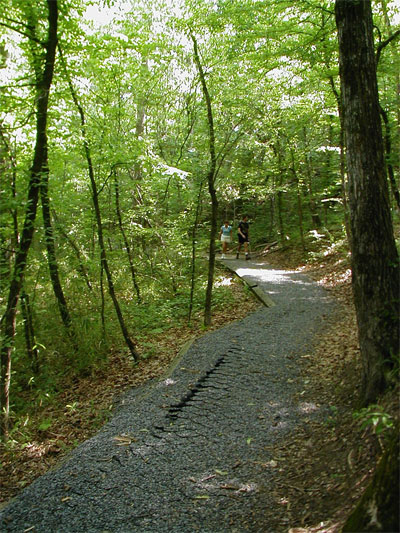
The trails wind through a floodplain forest of bottomland hardwoods, starting from the top of the bluff from which the park gets its name and descending some 75 feet into a cypress slough. The trail is well maintained, and unobtrusive signs here and there provide information. Visitors are warned to stay on the trails. Heed this advice; this little jewel of a park has all sorts of wildlife and you can spot plenty from the trail, if you look and listen.
I started my way down the trail, and as usual in summer, it is like entering a huge green, somewhat quiet and calming cathedral. Surprisingly, most of the traffic noise from the nearby Interstate 55 is more or less muted. Green is overwhelmingly the dominant color, with a few small flowers here and there.
Starting at the Overlook, just past the amphitheater, the museum's trails lead you along several levels, from the tops of the bluffs to the Pearl River floodplains below. Photo by Bill Pitts
I walked slowly, quietly and hopefully. While I had my binoculars around my neck, I was really birding by ear, that is listening for the songs and calls of various birds. Of course, the first thing I heard wasn't a bird, but a frog, the small Green Treefrog, who was soon joined by others for a minute or two.
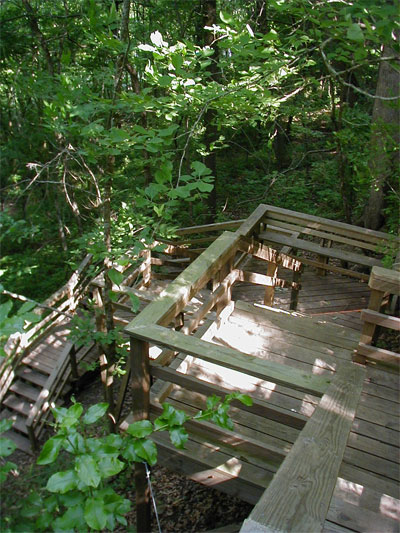
With a height comparable to a four-story building, these wooden stairs (left) aid the hiker in traversing the steep bluff. Photo by Bill Pitts
Birds began to call, Carolina Wrens saying teakettle teakettle; Northern Cardinals calling cheer cheer. In woodland situations, birds are more vocal simply because it is harder to see each other, so for right now birding by ear is the best way to see birds. I continued down the path. The canopy above blocked out the sky, except for where a tree had fallen, with new plant life growing toward the sun. Once I had counted the rings on one of these downed trees, and it had been 169 years old when it had crashed to the ground, making it a fairly young sapling in July of 1863.
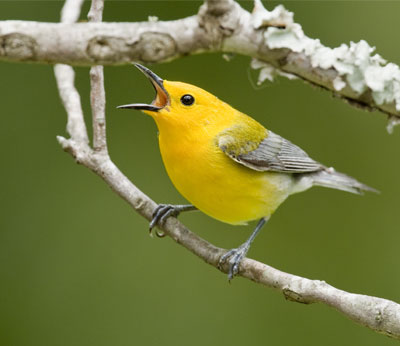
I descended the wooden stairs down the steep bluff though a stand of Oakleaf Hydrangea and stopped at the platform. I didn't have to wait long; a loud whit! whit! announced the presence of a Prothonotary Warbler. This was one of the birds I'd come to see.
Ranging from the Great Lakes to the Gulf States, the Prothonotary Warbler (right) prefers wooded swamps.
There are lots of warbler species, and aspiring birders tend to despair of being able to identify them all. However, the Prothonotary Warbler is the easiest to identify of all, a brilliant golden, albeit tiny, bird of the cypress swamps. Its song — that aforementioned whit! whit! — is incredibly loud for such a small bird. They nest in cavities (see photo at the end of this article) and take readily to nest boxes provided for them. The head and breast of the male are a brilliant golden-yellow with the back and tail an olive green, with the female differing only in being a slightly duller yellow.
I was watching the Prothonotaries flit back and forth across a slough, which relies on being flooded every so often by the Pearl River. In fact, this slough, along with the oxbow lakes in the Mayes Lake section used to be part of the Pearl River, but as all rivers and streams do, the Pearl meandered, eventually cutting them off, but for the replenishment of occasional flooding.
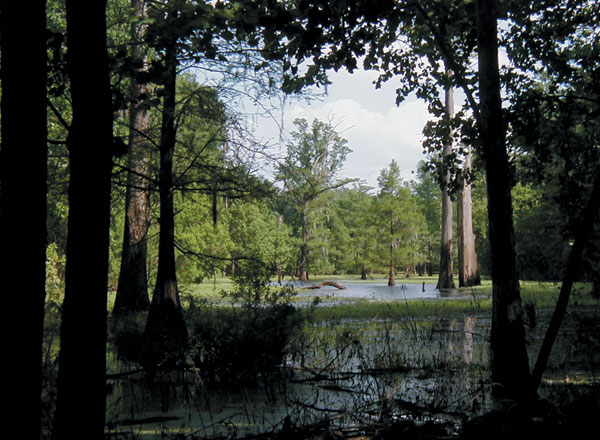
I checked the slough, looking especially at the logs and snags, hoping to find my second target bird, a Yellow-crowned Night-Heron, but no luck, so it was time to try for the one species of bird I always look for in here. I cleared my throat and began to hoot — hoo hoo-hoo hoo, hoo hoo-hoo hoo-ahh — the eight-noted call of the Barred Owl. John James Audubon called it "the noisiest of owls” and he was not exaggerating. Remember the habitat, deep forest, the green canopy blocking the sky, and it is easy to see why these owls are the archetypal "hoot owls;" the easiest way to keep in touch is by voice.
This view south from the Red Trail that leads across the flood plain shows one of the sloughs. Photo by Bill Pitts
What I was doing by hooting was "intruding" in the owls' territory, at the least hoping for a response. Summer is, however, not the best time to get a Barred Owl to hoot back at you, the reason being is they hopefully have fledged owlets waiting to be fed. So they tend not to waste energy hooting back at a trespasser.
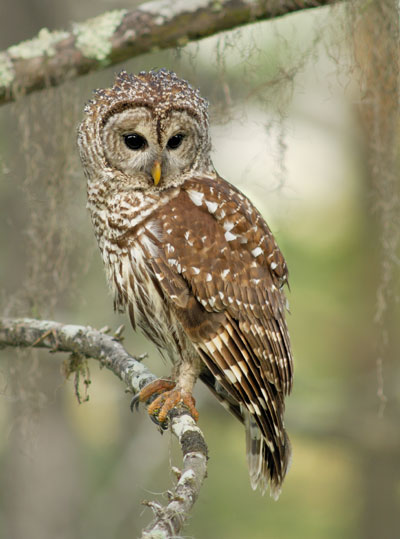
No reply came, and I moved slowly along the trail by the slough. Far ahead, two Great Egrets caught sight of me and took off, landing in the top of a cypress. I slowed, still scanning those floating snags, when, suddenly, up flew, not a night-heron, but a Barred Owl! He landed on a branch about halfway up a cypress tree. This owl had been sitting on a floating log an inch or so above the water's surface doing what owls do, watching for prey. While most people think of owls as being mousers, Barred Owls are opportunists when it comes to prey, which helps in survival. Very likely, he was looking for small bream, crawfish, or maybe even a small hatchling turtle.
Named for the markings across its chest and belly, the Barred Owl is another wooded swamps denizen.
Even though the owl had flushed up to the cypress branch and given me the once over, he still was staring down at water. I moved to get a better look with the binoculars to see whether it was an adult or young, and it was the former. Apparently that was one move too much as he took off into thicker vegetation where I couldn't see him, but things weren't over yet. Now, he began to hoot, maybe at me from my earlier noise-making, and I remembered I knew this Barred Owl. The best way to remember the Barred Owl call is the phrase "Who cooks for you? Who cooks for you-all?" The reason I "knew" this owl is because he always leaves out the first "for you." After two or three calls, from my left came another Barred Owl call, this one extremely loud, and, again up from a floating snag flew another owl into another cypress. This was the female of the pair. Now, one might ask how I knew which sex was which, and that would be a fair question. The way is to listen to the voice. The female's voice is higher pitched than the male, and male owls are smaller than females, often noticeably. She then flew into the top of the tallest tree in the slough, and in came the male after her.
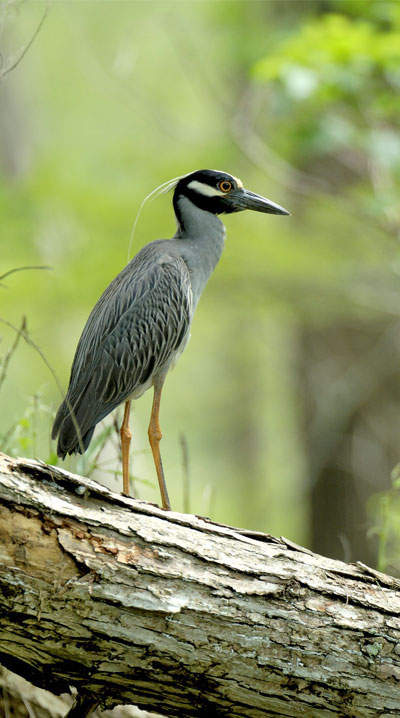
I left the owls alone; I had seen enough and as usual when I've seen Barred Owls, I was grinning. As I turned to leave, in sailed a Yellow-crowned Night-Heron! Shorter and stockier than most herons, this gray heron with a black and white head and a large yellow crown was likely after crawfish. They do forage at night, but most people probably see them flapping overhead at dusk calling "wok...wok...."
At home in cypress swamps, on bayous, marshes, and streams, the Yellow-Crowned Night Heron (left) feeds on crustaceans, mollusks, frogs, aquatic insects and small fish.
The Prothonotary Warbler (below) was named after golden-robed officials in the Roman Catholic Church known as the protonotarii.
It was time to go, so I walked the rest of the trail under the deep emerald green canopy, accompanied every so often by various dragonflies, until I left the calming woods. It had been a good day.
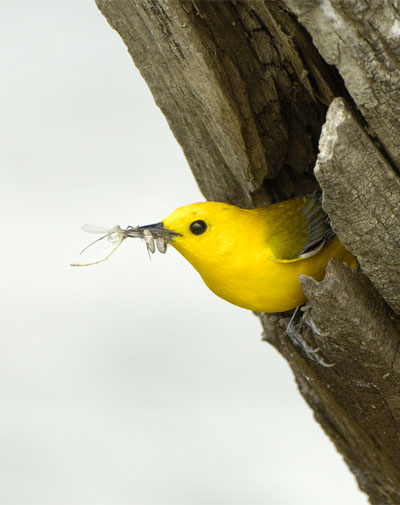
Editor's Note: For those of you who rely on wheeled mobility, the Mississippi Museum of Natural Science has constructed a single-level trail with a minimal grade that is a little over one-tenth of a mile in length, a portion of which is shown below. Photo by Bill Pitts
